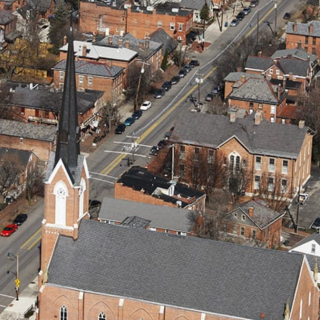Advertisement
The summer solstice of course is June 21st and we need to honor those who perhaps best celebrated Mother Earth’s longest day: Native Americans. While not definitively known, the summer solstice’s most sacred Ohio celebration in antiquity probably took place at Serpent Mound in Peebles County. And again, because no one definitively knows how old Serpent Mound is, the celebration itself could be thousands of years old. This year’s celebration begins this weekend and of course hosted by Friends of the Serpent Mound.
The following feature on Ohio Native American history and Indian mounds by an Ohio Bear Clan Seneca is a message to today’s Ohioans. Simply put, we need to recognize our ignorant past and amend our future.
Traditionally known as “The Land of the Three Miamis,” The Miamis in question were the Big and Little Miami Rivers running into the Ohio River, and the Maumee River running into Lake Erie. “Maumee” is a French mispronunciation of Miami. Ohio is one of those eighteen states with no reservations and no federally recognized Indians. This does not mean that there is no one indigenous to Ohio still living in Ohio. (Those Indigenous to and still in Ohio include Senecas, Wyandots, Cherokees, Lenapes, Shawnees, Miamis, Ottawas, Saponis, and Mahicans. In the 18th century, a group of Susquehannas sought and received refuge from their Iroquoian cousin.) It just means that everyone who does is officially snubbed. There is a reason for the snubbing: As the 18th-century’s “Indian Territory,” Ohio was and today remains a hotbed of resistance to invasion.
Before the American Revolution, the peoples here refused to allow the settlers in, despite the Washington family’s 1749 “Ohio Company” charter for the land. During the Revolution, especially the murderous years from 1779 to 1783, the starving and freezing Indians here held the line, pushing the American Revolutionary Army out, with its every attempt to enter. After the Revolution, George Washington was repeatedly frustrated in his efforts to parcel out Ohio in payment of “land warrants” that Revolutionary soldiers had “earned.” It was only after serial, failed military invasions of Ohio in 1790, 1791, and 1792, that in 1794 Anthony Wayne’s 5,000 soldiers overwhelmed the exhausted Indians, forcing the Greenville Treaty down their throats in 1795. Even then, a counter-council held in Detroit split the Indians, with a solid half refusing to have anything to do with the treaty.
Retribution for this determined resistance consisted of refusing Indians in Ohio any recognition or land, but handing it wholesale to the squatters rushing in. By 1817, the last tidbit of Ohio was seized, although resistance to invasion continued right through Ohio Removal, not “complete” till 1845, with one-fourth to one-third of the Indians even then refusing to leave the spirits of place or the graves of the ancestors. Instead, they hid out in the Appalachians to the southeast and the swamps in the northeast and southwest.
Ohio’s spirits of place and ancestors reside in numerous locales, particularly the multiplicity of sacred mounds dotting Ohio. Indian stories say that the oldest mounds go back more than 5,000 years. An antique Smithsonian agenda, however, insisted that Indians had arrived in North America only 2,000 years ago, with archaeologists still ridiculously dating all Ohio mounds to “about 2,000 years.” Additionally, well into the 20th century, “fantastic archaeology” claimed that a “lost, white” race of Mound Builders built the mounds, held Olympics there, and were “wiped out” by the heathen redskins. (See: Stephen Williams, Fantastic Archaeology: The Wild Side of North American Prehistory.)
The decimation of the mounds began in the 1790s, but between 1870 and 1900, there remained 12,000 mounds in Ohio, including platform (habitation) mounds; conical burial mounds; loaf mounds (marking highways); Circle (Breath/Air)–Square (Blood/Water) ceremonial complexes; and effigy pairs honoring Breath and Blood. By 1951, that count was down to 5,000, because farmers ploughed the mounds flat, the U.S. Army held artillery practice at mound complexes, and railroad companies used mounds as fill dirt, shoveling skeletons and grave goods, alike, under their tracks. Halves of effigies were destroyed, so that, for instance, the Great Horned Serpent Mound in Adams County is now bereft of his Thunderbird complement.
The destruction was premeditated, too. A magnificent burial mound located directly in the center of Ohio was right where the settlers decided to build their capital, Columbus. There, they “mined” the mound’s special burial clay to make bricks for the first Ohio State House, discarding as debris the skeletons it contained. That state house burned down in the early 1850s, with Indians claiming that the ancestors had fired it in outrage at the plunder of their cemetery.
Among the worst abuses of Ohio’s sacred mounds was the deliberate destruction of the stone pyramids. Between 1831 and 1832, for instance, settlers dismantled the highest of these, the 55-foot high sandstone pyramid at Flint Ridge. With a diameter at its base of 183 feet, it was the largest sandstone “mound” anywhere on record. Paved around the base with flat, worked stones, each weighing up to 60 pounds, the pyramid, itself, was constructed of large, sandstone blocks. Fifteen thousand wagonloads of stones were carted off, with the best stones used to build an entirely unnecessary reservoir. Leftover blocks were piled up to 12 feet high and scavenged by local farmers to build their cellar walls.
Many Ohio Indians attribute such heavy-handed obliteration of especially Ohio’s stone works to the racist claims that indigenous “savages” had no civilization—and never built in stone. When settlers encountered the undeniable evidence of worked-stone structures, they invented a “lost, white race” as their engineers. Nevertheless, knowing that Indians really had built everything, settlers also methodically destroyed the evidence.
Ohio Indians are not at all aided in their preservation efforts by the federal insistence that “there are no Indians left in Ohio.” Unfortunately, many federally recognized people buy this lie. Nevertheless, against all odds, Ohio peoples honorably retained their cultures, stories, and fires, with some even maintaining the old languages. Now that mean-spirited measures are in the U.S. Congress to terminate recognition for all Indians, everyone may well soon face the same hurdles that Ohio Indians have been clearing for two centuries.
Today, the Ohio fight rages to preserve what mounds continue to exist. In particular, Ohio Indians want the members-only Mound Builders Country Club removed from the massive Circle-Octagon earthworks, part of an ancient ceremonial complex that covers four square miles in Newark, Ohio. Indian burials have been removed from the complex. In 1925, a New York Times Magazine article documented “fourteen giant human skeletons” having been removed from the site. In 1939, Mary Orr, the diary-keeping wife of the club’s groundskeeper, was “forced to say” she knew nothing “of the discovery.” The Native American Alliance of Ohio’s position is that cemeteries should not be used as golf courses.
Ohio Indians are banned from entering the Circle-Octagon, with Bird Clan, Cherokee Grandmother Barbara Crandell arrested for trespassing in 2005 while praying at a site her own ancestors built. Simultaneously, golfers’ tees and clubs chip away at the sacred mounds daily. Heavy lawn-mowing equipment pushes the mounds closer to the ground with each pass, while poisonous “fertilizers” are regularly spread across the mounds.
Worst of all, Ohio Indians discovered the golf club has been sinking plaques to dead golfers, anchored below the frost level, into the mounds for years. Thirty-eight exist in the Octagon, with another 18 in the Circle. Although the Ohio Historical Society admitted in a meeting with the Native American Alliance of Ohio (NAAO) that this was an inappropriate use of the mounds, the plaques have yet to be removed, or even to be stopped from being placed.
Ohio Indians have publicized these facts and demonstrated against the club’s presence on the sacred mound complex. However, the only observable effects have been, first, an extended land lease granted the country club, and second, in 2014, a name change for the Historical Society to the “Ohio History Connection.” In 1999, the Historical Society and the golf club secretly re-signed a 1997 lease for the mounds (re-dated by hand to 1999) to run until 2078. This was in clear violation of Ohio Revised Code, Article 149.30, which states that the lease can run more than two years only with the consent of the State Attorney General.
The Ohio Attorney General at the time, Betty Montgomery, never authorized the extended lease. Moreover, the signatory for the Ohio Historical Society was not the typed-in president, Robert B. Smith, but Lucy Porter, who was listed on the lease as “president,” although she was neither a staff member of the Historical Society, nor as far as NAAO could determine, even a trustee at the time. “Robert B. Smith” was crossed out on the signature line, with “Lucy Porter” handwritten in.
As soon as NAAO learned of the illegal lease, its delegation went to the Attorney General’s office at the Ohio State House to inquire into it. Instead of honoring NAAO’s request to set a meeting with Attorney General Montgomery, the office clerks whispered nervously behind their hands and then ordered the delegation to leave the building. No Attorney General’s opinion has ever been published on this lease.
NAAO fears the foot-dragging on the matter is connected to the fact that the Country Club was created in 1911. This means that, conceivably, it could already register itself as a historical landmark. Shortly, some of the plaques to dead golfers will hit the 50-year mark for a historical designation of their own, which would make it impossible to remove them, in a warped insult to the complex’s original function as an Indian cemetery.
Barbara Alice Mann, an Ohio Bear Clan Seneca, is Ph.D scholar and professor in the Honors College at the University of Toledo. Mann has authored several books on Native American history and in particular Native American history in Ohio, such as Native Americans, Archaeologists, and the Mounds (American Indian Studies).



